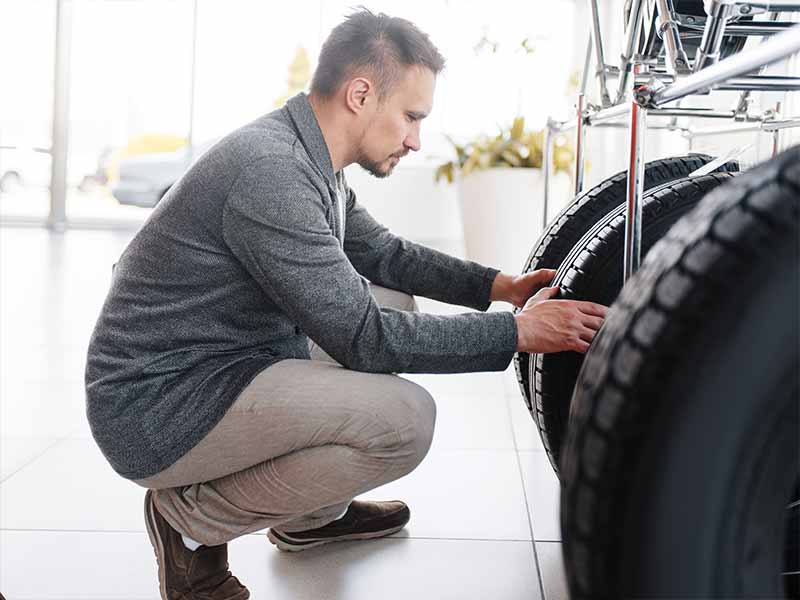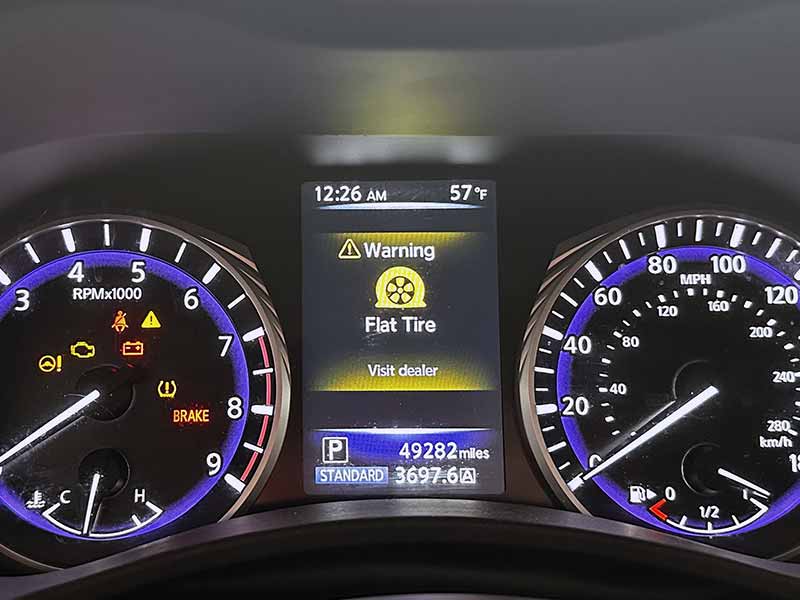Tires are the unsung heroes of our vehicles, silently bearing the weight and ensuring our journeys are smooth. But what happens when technology offers a twist in the tale of these rubber wonders? Enter the debate of run flat tires versus regular tires. The choice isn’t just about rubber; it’s about safety, convenience, and peace of mind.
Are Run Flat Tires Worth It?
Run flat tires are worth it for those that can afford the added cost, respond quickly to TMPS warnings, potentially shorter tread life, and don’t mind the harsher ride due to the stiffer sidewalls of run flats.
In this article, we’ll delve deep into the world of run flat and regular tires, exploring their advantages, disadvantages, and key considerations to help you make an informed decision for your vehicle.
Advantages of Run Flat Tires
Run flat tires have gained popularity among many vehicle manufacturers and drivers due to their unique features and benefits. Understanding these advantages can help drivers make informed decisions about whether run flat tires are suitable for their needs.
Enhanced Safety in Emergency Situations
- Reduced Risk of Blowouts: Traditional tires can blow out suddenly when punctured at high speeds. Run flat tires, with their reinforced design, reduce this risk, allowing drivers to maintain better control of their vehicle.
- Avoiding Dangerous Situations: Changing a tire on a busy highway or in an unsafe area can be hazardous. With run flat tires, drivers can continue to a safer location before addressing the tire issue.
Convenience and Peace of Mind
- No Immediate Tire Change Needed: After a puncture, run flat tires allow drivers to drive for a limited distance (usually 50 to 100 miles) without the immediate need to change the tire.
- Elimination of Spare Tire: Many vehicles equipped with run flat tires don’t come with a spare tire. This design choice provides more trunk space and reduces the vehicle’s overall weight, potentially improving fuel efficiency.
Space Optimization
- Increased Trunk Space: Without the need for a spare tire, vehicle manufacturers can offer more usable trunk space, allowing drivers to carry more cargo.
- Weight Reduction: Removing the spare tire and associated tools can lead to a slight reduction in vehicle weight, which might contribute to better fuel economy.
Modern Vehicle Integration
- Designed for Modern Cars: Many modern vehicles, especially luxury brands like BMW, are designed with run flat tires in mind. This integration ensures optimal performance and handling when using RFTs.
- Tire Pressure Monitoring System (TPMS): Vehicles with run flat tires often come equipped with a TPMS. This system alerts drivers when the tire pressure drops, ensuring they are aware of any potential issues and can take appropriate action.

Disadvantages of Run Flat Tires
While run flat tires offer numerous advantages, they also come with certain drawbacks. Being aware of these limitations can help drivers make a well-informed decision about whether or not to opt for run flat tires.
Limited Post-Puncture Driving Distance
- Shorter Range: Once punctured, run flat tires typically allow for a driving range of 50 to 100 miles. After this, they must be replaced or repaired.
- Speed Limitations: Even if the tire can support driving for a certain distance after a puncture, the recommended speed is usually reduced to ensure safety.
Potentially Rougher Ride
- Stiffer Sidewalls: The reinforced sidewalls that give run flat tires their self-supporting capability can also result in a firmer, less comfortable ride compared to regular tires.
- Increased Road Noise: Some drivers report that run flat tires can be noisier than their conventional counterparts.
Cost Implications
- Higher Initial Cost: Run flat tires are generally more expensive than regular tires due to their specialized construction.
- Replacement Over Repair: Many tire shops prefer to replace rather than repair punctured run flat tires, leading to potentially higher maintenance costs over the vehicle’s lifespan.
Specific Issues with Certain Brands
- BMW Run-Flat Tires Problems: Some BMW owners have reported issues with their run flat tires, such as quicker wear and tear or a harsher ride. It’s essential to research and consider brand-specific feedback when choosing tires.
Limited Availability and Replacement Options
- Not as Common: While run flat tires are becoming more popular, they are still not as widely available as regular tires. This limited availability can pose challenges when seeking replacements, especially in remote areas.
- Compatibility Concerns: Not all vehicles are designed to accommodate run flat tires. Switching from run flats to regular tires (or vice versa) on vehicles not designed for them can lead to performance and safety issues.

Regular Tires: What You Need to Know
Regular tires, often referred to as conventional or standard tires, have been the go-to choice for most vehicles for decades. While they don’t offer the same post-puncture driving capabilities as run flat tires, they come with their own set of advantages and characteristics.
Basic Construction and Function
- Flexible Sidewalls: Unlike the reinforced sidewalls of run flat tires, regular tires have more flexible sidewalls, which can contribute to a smoother ride.
- Air Pressure Reliance: Conventional tires rely heavily on maintaining the correct air pressure for optimal performance and safety. A significant drop in pressure can render them inoperable.
Advantages of Using Regular Tires
- Comfortable Ride: The flexible sidewalls of regular tires often result in a smoother and more comfortable ride compared to the stiffer run flat tires.
- Cost-Effective: Regular tires are generally less expensive than run flat tires, both in terms of initial purchase and potential repairs.
- Wider Availability: Given their long-standing use in the automotive industry, regular tires are widely available, making replacements and repairs more accessible.
- Potential for Repair: Unlike run flat tires, which are often replaced after a puncture, many regular tires can be repaired if the damage is not too severe.
Considerations When Using Regular Tires
- Need for a Spare: Vehicles equipped with regular tires typically come with a spare tire. Drivers should be familiar with how to change a tire or have a plan in place in case of a puncture.
- Safety Concerns: A sudden deflation, especially at high speeds, can be dangerous. Regular tire users should regularly check their tire pressure and condition to prevent such situations.
- Storage for Spare Tire: The inclusion of a spare tire means that some trunk space is taken up, potentially reducing the cargo capacity.

Switching Between the Two: What to Consider
When contemplating a switch between run flat and regular tires, or vice versa, there are several factors to consider. Making an informed decision ensures that the vehicle performs optimally and safely.
Vehicle Design and Calibration
- Manufacturer Recommendations: Some vehicles, especially luxury brands like BMW, are specifically designed with run flat tires in mind. Switching to regular tires on such vehicles might affect handling and performance.
- Suspension and Handling: Vehicles calibrated for run flat tires might have a suspension tuned to the stiffer sidewalls of these tires. Switching to regular tires could alter the vehicle’s handling characteristics.
Safety Systems and Monitoring
- Tire Pressure Monitoring System (TPMS): Vehicles equipped with run flat tires often have a TPMS to alert drivers of pressure loss. If switching to regular tires, it’s crucial to ensure the TPMS is still functional and calibrated correctly.
- Spare Tire Considerations: If switching from run flat to regular tires, drivers should consider equipping their vehicle with a spare tire or an emergency tire repair kit.
Cost and Longevity
- Initial Investment: While run flat tires tend to be more expensive initially, they might save costs in the long run by eliminating the need for a spare tire or by reducing the frequency of roadside tire changes.
- Wear and Tear: Some users report that run flat tires wear out faster than regular ones. It’s essential to factor in potential replacement costs when considering a switch.
Practical Implications
- Driving Habits and Conditions: Drivers who frequently travel in remote areas or places with limited tire service options might prefer the security of run flat tires. Conversely, those who prioritize ride comfort might lean towards regular tires.
- Switching from Run Flats to Regular Tires on a BMW: For BMW owners, it’s crucial to research and understand the specific implications of such a switch, given that many BMW models are designed with run flat tires in mind.
Expert Consultation
- Seek Professional Advice: Before making a switch, it’s advisable to consult with a tire expert or the vehicle manufacturer. They can provide insights into the potential benefits and drawbacks of the change for the specific vehicle model.

What are Run Flat Tires?
Run flat tires, often abbreviated as RFTs, are a special type of tire designed to remain functional for a limited distance even after they lose air pressure, such as from a puncture. This unique feature provides drivers with the ability to continue driving to a safe location or service center without the immediate need to change the tire.
How Do They Work?
Run flat tires are constructed differently from regular tires. Here are the key components that make them stand out:
- Reinforced Sidewalls: Unlike regular tires, RFTs have thicker and stiffer sidewalls. This reinforcement allows the tire to support the vehicle’s weight even when it’s deflated.
- Self-Supporting System: This system ensures that the tire maintains its shape and doesn’t get squashed under the vehicle’s weight when it loses air.
Types of Run Flat Tires
There are primarily two types of run flat tire systems:
- Self-Supporting Run Flat Tires: These are the most common type. The stiff and reinforced sidewalls allow these tires to bear the weight of the vehicle even after a puncture.
- Support Ring System: This system uses a ring of hard material attached to the wheel. If the tire loses pressure, the ring supports the weight of the vehicle.
Benefits of Using Run Flat Tires
While the primary advantage of run flat tires is the ability to continue driving after a puncture, there are other benefits:
- Safety: Reduces the risk of accidents caused by sudden deflation, especially at high speeds.
- Convenience: Eliminates the immediate need to change a tire on the roadside, which can be particularly beneficial in adverse weather conditions or unsafe locations.
- Space-Saving: Since there’s less need for a spare tire, vehicle manufacturers can design trunks with more usable space.
Limitations to Consider
While run flat tires offer several advantages, they come with limitations:
- Driving Range: After a puncture, you can typically drive for about 50 to 100 miles, depending on the tire and vehicle specifications. It’s crucial to get the tire checked or replaced after this.
- Tire Pressure Monitoring System (TPMS): Vehicles equipped with RFTs usually have a TPMS to alert the driver when tire pressure drops. It’s essential to ensure this system is always functional.
Resources
Below are some links you may find helpful when learning about tires
Final Thoughts
While run flat tires offer the undeniable advantage of post-puncture driving, ensuring safety and convenience, regular tires are often favored for their comfort and cost-effectiveness. It’s essential to weigh the pros and cons of each, considering factors like vehicle design, driving conditions, and personal preferences.





